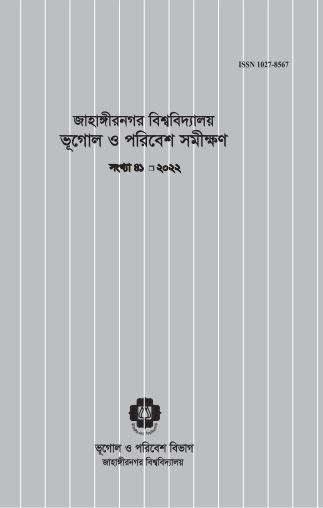গঙ্গা-যমুনা নদীর মিলনস্থল আরিচায় চার দশকের (১৯৮০-২০২২) পানিতাত্ত্বিক বৈশিষ্টের বিশ্লেষণ
Main Article Content
Abstract
River systems plays a crucial role in riverine countries like Bangladesh. We depend on rivers for various needs including agriculture, shipping, fisheries, environment and climate. The normal flow of a river change over time due to various reasons. For instance, due to siltation, the water carrying capacity and plan view of a river changes. For this reason, a clear understanding of the hydrological characteristics of a river is essential. Hydrological characteristics of a river mainly include three aspects: a) water level and discharge b) amount of sediment and c) sediment size. The present study analyzed only monthly, seasonally and annual water level and discharge at the GangaJamuna River confluence at Aricha and second station at Baruria of the upstream of the Jamuna river. For this purpose, the water level and discharge data of the last 42 years (1980-2022) of two stations (Aricha and Baruria) were collected from Bangladesh Water Development Board (BWDB). Descriptive statistics have been used to analyze the data. The result reveals that the annual maximum, minimum and average water levels of Aricha station are 5.91, 4.95 and 5.45 meters respectively. On the other hand, the annual maximum, minimum and average water levels at Baruria (Jamuna) station are 5.12, 4.14 and 4.60 meters respectively. From monthly water level results, maximum water level exists in July and minimum in February at the both stations. Aricha station has an average water level of 8.09 meter during monsoon (July–September) and a minimum of 3.18 meter during dry season (December-February) i.e., the seasonal difference 4.91 meter. On the other hand, Baruria station has a maximum water level of 7.09 meter in monsoon, and a minimum of 2.42 meter in dry season i.e., the seasonal difference 4.62 meter. The water level and water discharge at both stations are seasonal which is a reflection of the basin scale water availability. The annual maximum, minimum and average of discharge at Baruria station are 60625.57, 15359.63 and 30535.52 m3/s respectively. Most of the water level and discharge in Aricha comes from the Jamuna. Out of 42 years of annual water level data at Aricha station, 18 years had below average levels and 24 years had above average levels. At Baruria station, 23 years were below average and 19 years were above average. Water conservation management initiatives can be taken both at the local and basin scale to reduce seasonal water level and flow variations of the rivers of Bangladesh.

